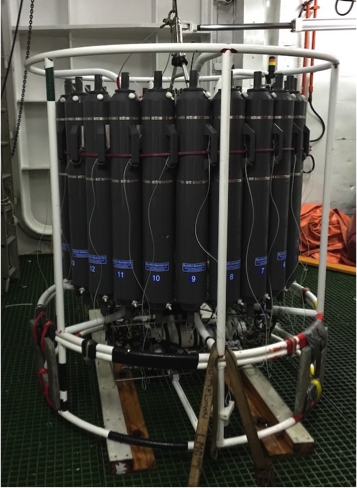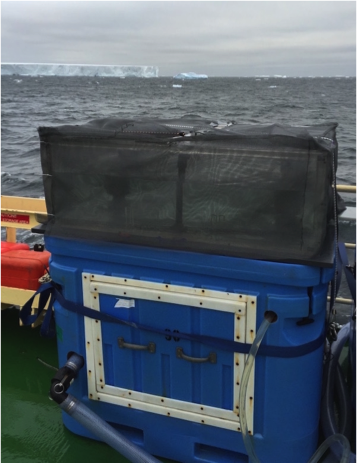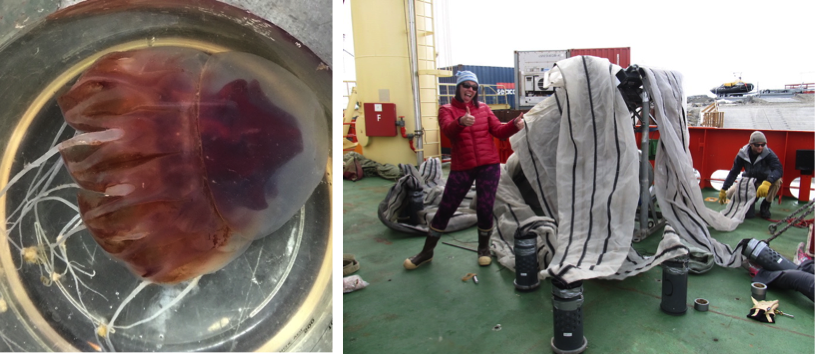February 2nd, 2016
By: Carly Moreno
Don’t let the word ‘cruise’ confuse you; a research cruise is a lot of work, especially one that’s 6 weeks long! Science is 24/7, and some days there’s very little time for sleep or proper meals. Just yesterday, I was awake for over 20 hours working on my experiments and helping other scientists with their work. The work is generally tedious, but it’s interesting to see the changes that take place as we move from station to station. Of course, working in such a beautiful place like Antarctica makes everything worthwhile.

The CTD rosette measures conductivity (salinity), temperature, and pressure (depth). The niskin bottles surround the rosette and are fired at specific depths to capture water.
Most of what we do is filter a lot of water onto small, white, paper-like circles to analyze back in the lab. As part of Oscar Schofield’s phytoplankton group, our goals are to monitor the biomass, health, and productivity of the phytoplankton community and add to the 24-year time series of phytoplankton data. In order to do this, we first collect water with a CTD rosette and nisken bottles (shown at right). At every station we lower the rosette and measure physical, chemical, and biological parameters of the ocean. Then we capture water at specific depths to make our measurements.
We measure phytoplankton biomass by taking samples for chlorophyll a and pigments. Chlorophyll a is a light-harvesting molecule found in all photosynthetic organisms and is used to estimate the biomass and amount of phytoplankton in the water. Pigments are used to detect shifts in community composition between broad groups of phytoplankton. We assess the health of the phytoplankton community by measuring the efficiency of their photosynthetic apparatus with a fluorescence induction and relaxation (FIRE) machine.
Finally, we measure primary production with 14C-bicarbonate uptake experiments. In these experiments, we collect water in glass bottles and spike it with radiolabeled bicarbonate. Then we put the bottles in an incubator with flowing seawater and different amounts of screening material to stimulate different light levels (shown below). The bottles are left in the incubator for 24 hours to allow the phytoplankton to grow and incorporate the 14C into their cells.

An incubator filled with flowing seawater and covered with screening material to stimulate 33% light level in the ocean. Bottles for my own experiments and for other scientists await filtering.
Since phytoplankton are microscopic and filtering 50 liters of water can get really boring, sometimes I like to visit the zooplankton lab, where you can actually see animals with your naked eye. On top of the huge amount of krill and copepods they find everyday, they also find some larger animals like jellyfish, fish larvae, pteropods, decapods, and salps. The zooplankton group uses several types of nets to capture different sizes of animals: a 1 meter net that catches small copepods, and a 2 meter net that catches larger critters. Their most impressive net is the MOCNESS (Multiple Opening-Closing Net Environmental Sensing System). It is the biggest net that I’ve seen and it consists of 8 separate nets that can be opened and closed at discrete depth intervals. They deploy it in the canyon regions along the WAP to investigate depth distribution and diel vertical migration of zooplankton. Their goals for this cruise are to constrain the role zooplankton play in the biological pump and nutrient cycling through grazing, particle or fecal pellet production, and diel vertical migration. They are also interested in understanding the effects of climate change on zooplankton community on the continental shelf of the WAP.


University Operator: (919) 962-2211 | © 2024 The University of North Carolina at Chapel Hill |